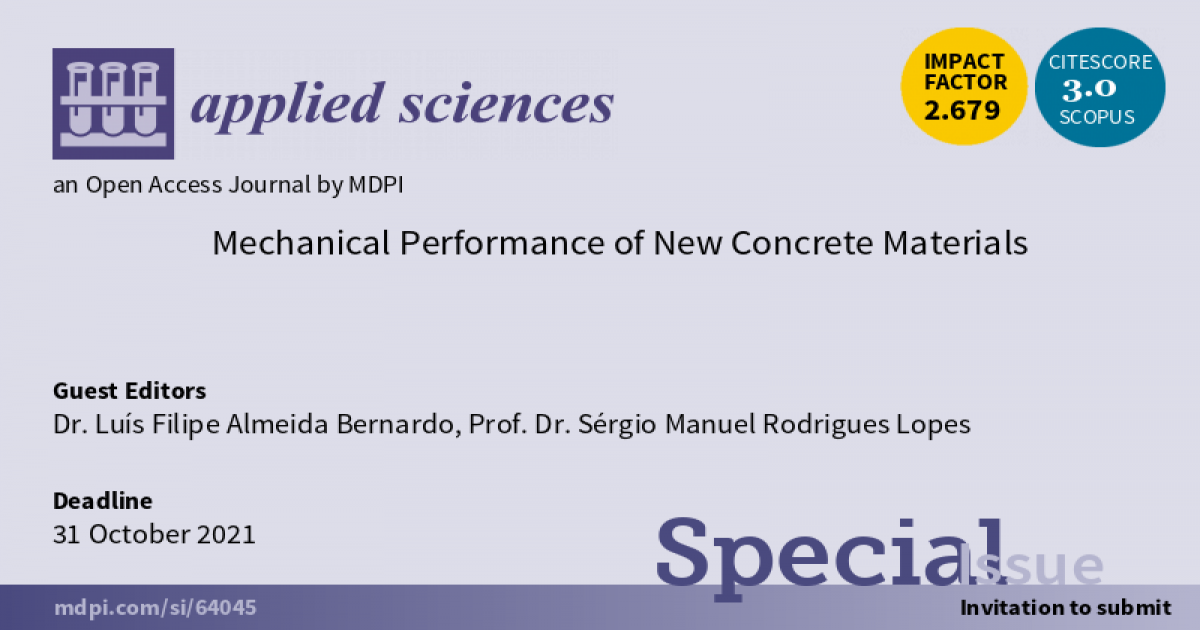Mechanical Performance of New Concrete Materials
A special issue of Applied Sciences (ISSN 2076-3417). This special issue belongs to the section "Civil Engineering".
Deadline for manuscript submissions: closed (31 October 2021) | Viewed by 9329
Related Special Issue: High-Performance Eco-Efficient Concrete

Special Issue Editors
Interests: structural analysis and design; numerical modelling and optimization; concrete structures; structural materials; building systems
Special Issues, Collections and Topics in MDPI journals
Interests: behavior of structural concrete; high strength structures; non metalic reinforcement; noncementitious concretes; composite timber–concrete structures
Special Issue Information
Dear Colleagues,
Concrete production has been under pressure from public opinion for some decades because of the high level of CO2 emissions associated with it. As a consequence, governmental authorities have been taking some practical measures to make the industry more eco-friendly. For instance, the 2015 Paris Agreement on climate change imposed to the cement industry a reduction on CO2 emissions of at least 16 per cent by 2030. This pressure really forces the cement industry to intensify the search for new alternative production technologies and materials.
Changes on cement production are expected. Obviously, non-cementitious materials must be also considered as an alternative route of the entire road map to low emission construction production. Various research works on alternative materials to ordinary Portland concrete (OPC) have been published in the last three decades, but OPC continues to dominate the market at present.
Concerning the new types of concretes, almost all of the published works are focused on the development of the material itself, including the mechanical properties. So far, very few studies have been concerned with the structures themselves.
Therefore, the editors of this Special Issue want to group a number of studies from a material point of view to the structures. Since the main lack of knowledge is in the structural behavior of the structures, new studies on this aspect will be most welcome.
The Special Issued aims to focus on the mechanical performance implications of using new materials, such as new cementitious binders, alkali-activated materials or other types of nonconventional concretes.
Assistant Professor with Aggregation Luís Filipe Almeida Bernardo
Prof. Sérgio Manuel Rodrigues Lopes
Guest Editors
Manuscript Submission Information
Manuscripts should be submitted online at www.mdpi.com by registering and logging in to this website. Once you are registered, click here to go to the submission form. Manuscripts can be submitted until the deadline. All submissions that pass pre-check are peer-reviewed. Accepted papers will be published continuously in the journal (as soon as accepted) and will be listed together on the special issue website. Research articles, review articles as well as short communications are invited. For planned papers, a title and short abstract (about 100 words) can be sent to the Editorial Office for announcement on this website.
Submitted manuscripts should not have been published previously, nor be under consideration for publication elsewhere (except conference proceedings papers). All manuscripts are thoroughly refereed through a single-blind peer-review process. A guide for authors and other relevant information for submission of manuscripts is available on the Instructions for Authors page. Applied Sciences is an international peer-reviewed open access semimonthly journal published by MDPI.
Please visit the Instructions for Authors page before submitting a manuscript. The Article Processing Charge (APC) for publication in this open access journal is 2400 CHF (Swiss Francs). Submitted papers should be well formatted and use good English. Authors may use MDPI's English editing service prior to publication or during author revisions.
Keywords
- Nonconventional concrete
- Mechanical performance
- Structural applications
- Experimental findings
- Analytical and numerical models
- Design
Benefits of Publishing in a Special Issue
- Ease of navigation: Grouping papers by topic helps scholars navigate broad scope journals more efficiently.
- Greater discoverability: Special Issues support the reach and impact of scientific research. Articles in Special Issues are more discoverable and cited more frequently.
- Expansion of research network: Special Issues facilitate connections among authors, fostering scientific collaborations.
- External promotion: Articles in Special Issues are often promoted through the journal's social media, increasing their visibility.
- e-Book format: Special Issues with more than 10 articles can be published as dedicated e-books, ensuring wide and rapid dissemination.
Further information on MDPI's Special Issue polices can be found here.






